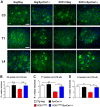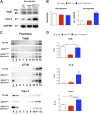Neuron-targeted caveolin-1 improves neuromuscular function and extends survival in SOD1G93A mice
- PMID: 30894019
- PMCID: PMC6529340
- DOI: 10.1096/fj.201802652RR
Neuron-targeted caveolin-1 improves neuromuscular function and extends survival in SOD1G93A mice
Abstract
Interventions that preserve motor neurons or restore functional motor neuroplasticity may extend longevity in amyotrophic lateral sclerosis (ALS). Delivery of neurotrophins may potentially revive degenerating motor neurons, yet this approach is dependent on the proper subcellular localization of neurotrophin receptor (NTR) to plasmalemmal signaling microdomains, termed membrane/lipid rafts (MLRs). We previously showed that overexpression of synapsin-driven caveolin-1 (Cav-1) (SynCav1) increases MLR localization of NTR [e.g., receptor tyrosine kinase B (TrkB)], promotes hippocampal synaptic and neuroplasticity, and significantly improves learning and memory in aged mice. The present study crossed a SynCav1 transgene-positive (SynCav1+) mouse with the mutant human superoxide dismutase glycine to alanine point mutation at amino acid 93 (hSOD1G93A) mouse model of ALS. When compared with hSOD1G93A, hSOD1G93A/SynCav1+ mice exhibited greater body weight and longer survival as well as better motor function. Microscopic analyses of hSOD1G93A/SynCav1+ spinal cords revealed preserved spinal cord α-motor neurons and preserved mitochondrial morphology. Moreover, hSOD1G93A/SynCav1+ spinal cords contained more MLRs (cholera toxin subunit B positive) and MLR-associated TrkB and Cav-1 protein expression. These findings demonstrate that SynCav1 delays disease progression in a mouse model of ALS, potentially by preserving or restoring NTR expression and localization to MLRs.-Sawada, A., Wang, S., Jian, M., Leem, J., Wackerbarth, J., Egawa, J., Schilling, J. M., Platoshyn, O., Zemljic-Harpf, A., Roth, D. M., Patel, H. H., Patel, P. M., Marsala, M., Head, B. P. Neuron-targeted caveolin-1 improves neuromuscular function and extends survival in SOD1G93A mice.
Keywords: MLR; TrkB; mitochondria; motor neurons; neuroplasticity.
Conflict of interest statement
The authors thank Ying Jones, Vanessa Taupin, and Timo Meerlo [University of California–San Diego (UCSD) Electron Microscopy Core] for preparation of the spinal cord samples and training on electron microscopy. The authors also thank Dr. Marilyn Farquhar (UCSD) for consultation on the project. The electron micrographs were taken in the Cellular and Molecular Medicine Electron Microscopy Core Facility, which is supported, in part, by the U.S. National Institutes of Health (NIH) Office of the Director Award S10OD023527. Work in the researchers’ laboratories was supported by a Veteran Affairs Merit Award from the Department of Veterans Affairs BX003671 (to B.P.H.), BX000783 (to D.M.R.), and BX001963 (to H.H.P.), and NIH National Institute of Neurological Disorders and Stroke Grant NS073653 (to B.P.H.), NIH National Heart, Lung, and Blood Institute Grants HL091071 and HL107200 (to H.H.P.), and NIH National Institute of General Medical Sciences Grant GM085179 (to P.M.P.). D.M.R., P.M.P., H.H.P., and B.P.H. are scientific founders of CavoGene LifeSciences LLC, and hold equity interest in the company. A.S. and S.W. share equal first authorship. The authors declare no other conflicts of interest.
Figures






Similar articles
-
Subpial delivery of adeno-associated virus 9-synapsin-caveolin-1 (AAV9-SynCav1) preserves motor neuron and neuromuscular junction morphology, motor function, delays disease onset, and extends survival in hSOD1G93A mice.Theranostics. 2022 Jul 11;12(12):5389-5403. doi: 10.7150/thno.72614. eCollection 2022. Theranostics. 2022. PMID: 35910808 Free PMC article.
-
Neuron-specific caveolin-1 overexpression improves motor function and preserves memory in mice subjected to brain trauma.FASEB J. 2017 Aug;31(8):3403-3411. doi: 10.1096/fj.201601288RRR. Epub 2017 Apr 27. FASEB J. 2017. PMID: 28450301 Free PMC article.
-
Toll-Like Receptor-4 Inhibitor TAK-242 Attenuates Motor Dysfunction and Spinal Cord Pathology in an Amyotrophic Lateral Sclerosis Mouse Model.Int J Mol Sci. 2017 Aug 1;18(8):1666. doi: 10.3390/ijms18081666. Int J Mol Sci. 2017. PMID: 28763002 Free PMC article.
-
Transgenic mice with human mutant genes causing Parkinson's disease and amyotrophic lateral sclerosis provide common insight into mechanisms of motor neuron selective vulnerability to degeneration.Rev Neurosci. 2007;18(2):115-36. doi: 10.1515/revneuro.2007.18.2.115. Rev Neurosci. 2007. PMID: 17593875 Review.
-
MicroRNA expression in animal models of amyotrophic lateral sclerosis and potential therapeutic approaches.Neural Regen Res. 2022 Apr;17(4):728-740. doi: 10.4103/1673-5374.322431. Neural Regen Res. 2022. PMID: 34472458 Free PMC article. Review.
Cited by
-
Subpial delivery of adeno-associated virus 9-synapsin-caveolin-1 (AAV9-SynCav1) preserves motor neuron and neuromuscular junction morphology, motor function, delays disease onset, and extends survival in hSOD1G93A mice.Theranostics. 2022 Jul 11;12(12):5389-5403. doi: 10.7150/thno.72614. eCollection 2022. Theranostics. 2022. PMID: 35910808 Free PMC article.
-
Ion Channel Regulation in Caveolae and Its Pathological Implications.Cells. 2025 Apr 24;14(9):631. doi: 10.3390/cells14090631. Cells. 2025. PMID: 40358155 Free PMC article. Review.
-
Mendelian Randomization Analysis Reveals Statins Potentially Increase Amyotrophic Lateral Sclerosis Risk Independent of Peripheral Cholesterol-Lowering Effects.Biomedicines. 2023 May 4;11(5):1359. doi: 10.3390/biomedicines11051359. Biomedicines. 2023. PMID: 37239030 Free PMC article.
-
Rare Variant Burden Analysis within Enhancers Identifies CAV1 as an ALS Risk Gene.Cell Rep. 2020 Dec 1;33(9):108456. doi: 10.1016/j.celrep.2020.108456. Cell Rep. 2020. PMID: 33264630 Free PMC article.
-
Glycerophospholipids in ALS: insights into disease mechanisms and clinical implication.Mol Neurodegener. 2025 Jul 26;20(1):85. doi: 10.1186/s13024-025-00876-3. Mol Neurodegener. 2025. PMID: 40713843 Free PMC article. Review.
References
-
- Kiernan M. C., Vucic S., Cheah B. C., Turner M. R., Eisen A., Hardiman O., Burrell J. R., Zoing M. C. (2011) Amyotrophic lateral sclerosis. Lancet 377, 942–955 - PubMed
-
- O’Connor D. M., Boulis N. M. (2015) Gene therapy for neurodegenerative diseases. Trends Mol. Med. 21, 504–512; erratum: 22, 266 - PubMed
-
- Brown R. H., Al-Chalabi A. (2017) Amyotrophic lateral sclerosis. N. Engl. J. Med. 377, 162–172 - PubMed
-
- Hardiman O., van den Berg L. H. (2017) Edaravone: a new treatment for ALS on the horizon? Lancet Neurol. 16, 490–491 - PubMed
Publication types
MeSH terms
Substances
Grants and funding
LinkOut - more resources
Full Text Sources
Molecular Biology Databases
Miscellaneous

